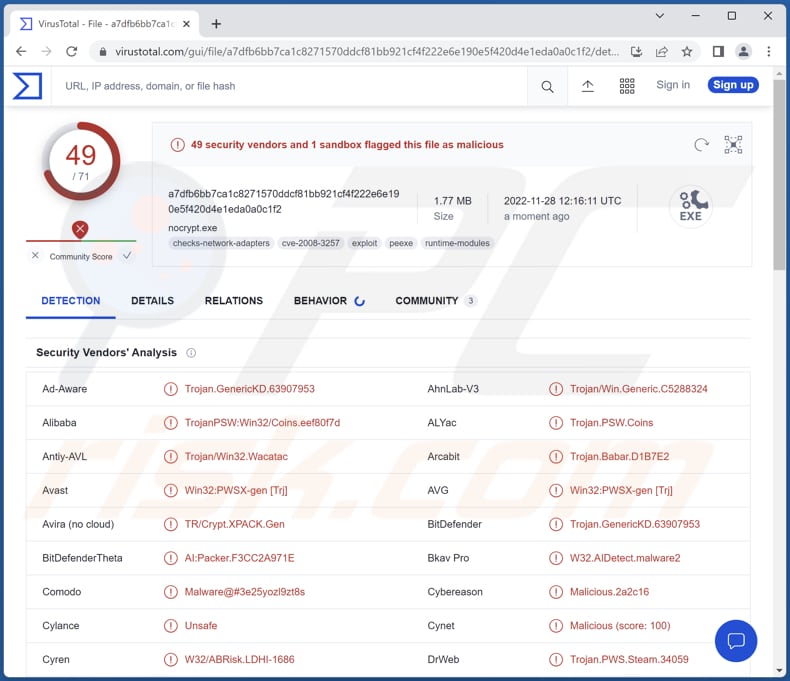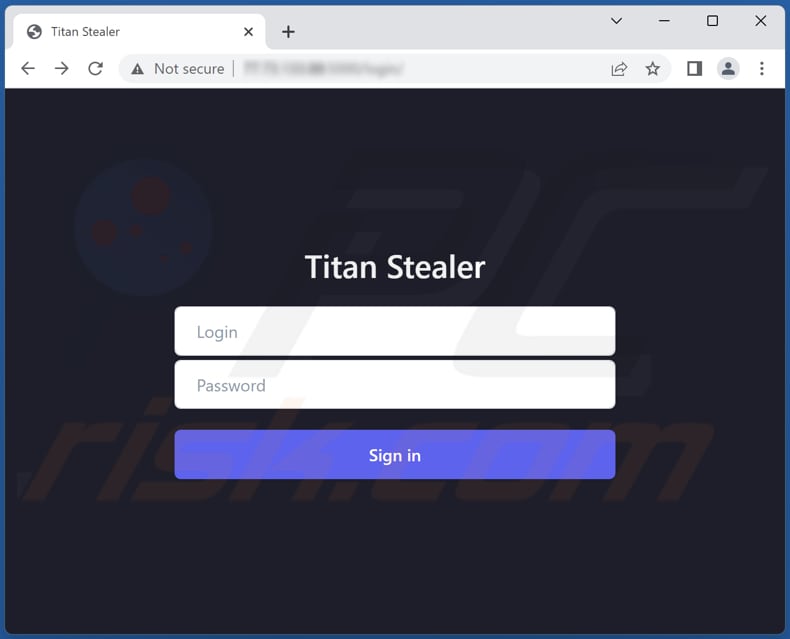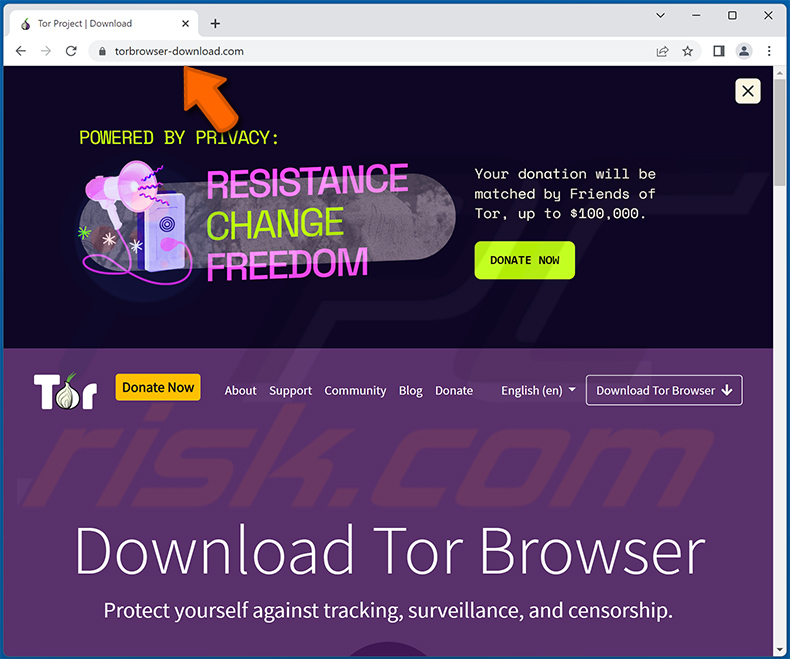Get free scan and check if your device is infected.
Remove it nowTo use full-featured product, you have to purchase a license for Combo Cleaner. Seven days free trial available. Combo Cleaner is owned and operated by RCS LT, the parent company of PCRisk.com.
What kind of malware is Titan?
While investigating malware samples submitted to VirusTotal, our team discovered an information stealer called Titan. Malware of this type gathers sensitive data from the infected system and sends it to the attacker. Typically, cybercriminals behind information stealers are financially motivated.

More about information stealers
Information-stealing malware can extract a variety of sensitive data from infected computers. It can data from web browsers, clipboards, FTP and VPN clients, email clients, messengers, password managers, and other installed applications. Also, it can gather information about the infected machine itself.
Typically, cybercriminals target usernames and passwords, cookies, autofill data, credit card details, tokens, crypto-wallet information, and other sensitive information. They misuse obtained data to steal identities, money, online accounts, and other purposes. In some cases, they can use it to deploy malware (e.g., ransomware).
Information stealers can be capable of logging keystrokes. They can record all data typed with the keyboard (record keyboard input). Also, they can capture screenshots and access a webcam, record microphone input, etc.
| Name | Titan information stealer |
| Threat Type | Trojan, password-stealing virus, banking malware, spyware. |
| Detection Names | Avast (Win32:PWSX-gen [Trj]), Combo Cleaner (Trojan.GenericKD.63907953), ESET-NOD32 (A Variant Of WinGo/Spy.Agent.AI), Kaspersky (Trojan-PSW.Win32.Coins.adxo), Microsoft (Trojan:Win32/Casdet!rfn), Full List (VirusTotal) |
| Symptoms | Information stealers are designed to stealthily infiltrate the victim's computer and remain silent, and thus no particular symptoms are clearly visible on an infected machine. |
| Distribution methods | Infected email attachments, malicious online advertisements, social engineering, software 'cracks'. |
| Damage | Stolen passwords and banking information, identity theft, monetary loss, loss of online accounts. |
| Malware Removal (Windows) |
To eliminate possible malware infections, scan your computer with legitimate antivirus software. Our security researchers recommend using Combo Cleaner. Download Combo CleanerTo use full-featured product, you have to purchase a license for Combo Cleaner. 7 days free trial available. Combo Cleaner is owned and operated by RCS LT, the parent company of PCRisk.com. |
Possible consequences
Victims lose money (including cryptocurrency), and personal accounts (e.g., email, social media, banking, gaming, and other accounts), have their identities stolen and encounter other issues. It is important to mention that threat actors can use stolen accounts to trick other users into infecting their computers with information stealers or other malware.
Cybercriminals behind information stealers misuse extracted data by themselves or sell it to third parties (other threat actors). Examples of different information stealers are XStealer, RAXNET, and StrelaStealer.
How did Titan infiltrate my computer?
Malware is distributed by hiding it in installers for pirated software, cracking tools, game cheats, code generators, etc. Also, cybercriminals use email to deliver malware - they send emails containing malicious links or attachments.
In other cases, threat actors use P2P networks, deceptive websites, free file hosting pages, freeware download sites, and similar channels to trick users into downloading and executing malware. Fake software updating tools and Trojans are also used to proliferate malicious software.
Typically, cybercriminals attempt to trick users into opening malicious MS Office or PDF documents, files within archives like ZIP and RAR, executables, JavaScript files, ISO files, etc.
How to avoid installation of malware?
Download software from official web pages and stores. Avoid downloads from other sources (examples are mentioned in the previous section). Examine emails before clicking links or opening files in them (irrelevant emails sent from suspicious/unknown addresses often contain malicious links or files).
Keep your computer (the operating system and installed programs) updated. Do not use third-party (unofficial) tools to update or activate any software. Do not trust ads or links on shady websites. If you believe that your computer is already infected, we recommend running a scan with Combo Cleaner Antivirus for Windows to automatically eliminate infiltrated malware.
Titan's administration panel:

Screenshot of a fake Tor browser download website (torbrowser-download[.]com) used to spread Titan stealer:

Instant automatic malware removal:
Manual threat removal might be a lengthy and complicated process that requires advanced IT skills. Combo Cleaner is a professional automatic malware removal tool that is recommended to get rid of malware. Download it by clicking the button below:
DOWNLOAD Combo CleanerBy downloading any software listed on this website you agree to our Privacy Policy and Terms of Use. To use full-featured product, you have to purchase a license for Combo Cleaner. 7 days free trial available. Combo Cleaner is owned and operated by RCS LT, the parent company of PCRisk.com.
Quick menu:
How to remove malware manually?
Manual malware removal is a complicated task - usually it is best to allow antivirus or anti-malware programs to do this automatically. To remove this malware we recommend using Combo Cleaner Antivirus for Windows.
If you wish to remove malware manually, the first step is to identify the name of the malware that you are trying to remove. Here is an example of a suspicious program running on a user's computer:

If you checked the list of programs running on your computer, for example, using task manager, and identified a program that looks suspicious, you should continue with these steps:
 Download a program called Autoruns. This program shows auto-start applications, Registry, and file system locations:
Download a program called Autoruns. This program shows auto-start applications, Registry, and file system locations:

 Restart your computer into Safe Mode:
Restart your computer into Safe Mode:
Windows XP and Windows 7 users: Start your computer in Safe Mode. Click Start, click Shut Down, click Restart, click OK. During your computer start process, press the F8 key on your keyboard multiple times until you see the Windows Advanced Option menu, and then select Safe Mode with Networking from the list.

Video showing how to start Windows 7 in "Safe Mode with Networking":
Windows 8 users: Start Windows 8 is Safe Mode with Networking - Go to Windows 8 Start Screen, type Advanced, in the search results select Settings. Click Advanced startup options, in the opened "General PC Settings" window, select Advanced startup.
Click the "Restart now" button. Your computer will now restart into the "Advanced Startup options menu". Click the "Troubleshoot" button, and then click the "Advanced options" button. In the advanced option screen, click "Startup settings".
Click the "Restart" button. Your PC will restart into the Startup Settings screen. Press F5 to boot in Safe Mode with Networking.

Video showing how to start Windows 8 in "Safe Mode with Networking":
Windows 10 users: Click the Windows logo and select the Power icon. In the opened menu click "Restart" while holding "Shift" button on your keyboard. In the "choose an option" window click on the "Troubleshoot", next select "Advanced options".
In the advanced options menu select "Startup Settings" and click on the "Restart" button. In the following window you should click the "F5" button on your keyboard. This will restart your operating system in safe mode with networking.

Video showing how to start Windows 10 in "Safe Mode with Networking":
 Extract the downloaded archive and run the Autoruns.exe file.
Extract the downloaded archive and run the Autoruns.exe file.

 In the Autoruns application, click "Options" at the top and uncheck "Hide Empty Locations" and "Hide Windows Entries" options. After this procedure, click the "Refresh" icon.
In the Autoruns application, click "Options" at the top and uncheck "Hide Empty Locations" and "Hide Windows Entries" options. After this procedure, click the "Refresh" icon.

 Check the list provided by the Autoruns application and locate the malware file that you want to eliminate.
Check the list provided by the Autoruns application and locate the malware file that you want to eliminate.
You should write down its full path and name. Note that some malware hides process names under legitimate Windows process names. At this stage, it is very important to avoid removing system files. After you locate the suspicious program you wish to remove, right click your mouse over its name and choose "Delete".

After removing the malware through the Autoruns application (this ensures that the malware will not run automatically on the next system startup), you should search for the malware name on your computer. Be sure to enable hidden files and folders before proceeding. If you find the filename of the malware, be sure to remove it.

Reboot your computer in normal mode. Following these steps should remove any malware from your computer. Note that manual threat removal requires advanced computer skills. If you do not have these skills, leave malware removal to antivirus and anti-malware programs.
These steps might not work with advanced malware infections. As always it is best to prevent infection than try to remove malware later. To keep your computer safe, install the latest operating system updates and use antivirus software. To be sure your computer is free of malware infections, we recommend scanning it with Combo Cleaner Antivirus for Windows.
Frequently Asked Questions (FAQ)
My computer is infected with Titan malware, should I format my storage device to get rid of it?
Titan can be removed from the operating system with an antivirus software or manually (see our removal guide).
What are the biggest issues that malware can cause?
Identity theft, financial losses, decreased computer performance, additional infections, data loss, stolen online accounts, etc. It depends on the capabilities of specific malware.
What is the purpose of Titan malware?
Titan is an information stealer. It may steal usernames, passwords, and other login information from web browsers, installed clients, and other apps. Also, it may be designed to log keystrokes, steal clipboard data, crypto-wallet information, and more.
How did a malware infiltrate my computer?
Malware is often hidden in cracked software, cracking tools, game cheats, etc. Also, it is distributed via email (links or attachments), P2P networks, free file hosting pages, third-party downloaders, fake software updating tools, Trojans, etc.
Will Combo Cleaner protect me from malware?
Combo Cleaner will remove detected malware (it can detect almost all known malware). It is important to run a full system scan to eliminate high-end malware since it often hides deep in the operating system.
Share:

Tomas Meskauskas
Expert security researcher, professional malware analyst
I am passionate about computer security and technology. I have an experience of over 10 years working in various companies related to computer technical issue solving and Internet security. I have been working as an author and editor for pcrisk.com since 2010. Follow me on Twitter and LinkedIn to stay informed about the latest online security threats.
PCrisk security portal is brought by a company RCS LT.
Joined forces of security researchers help educate computer users about the latest online security threats. More information about the company RCS LT.
Our malware removal guides are free. However, if you want to support us you can send us a donation.
DonatePCrisk security portal is brought by a company RCS LT.
Joined forces of security researchers help educate computer users about the latest online security threats. More information about the company RCS LT.
Our malware removal guides are free. However, if you want to support us you can send us a donation.
Donate
▼ Show Discussion